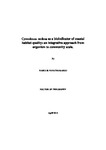Cymodocea nodosa as a bioindicator of coastal habitat quality: an integrative approach from organism to community scale.
| dc.contributor.supervisor | Brown, Murray T | |
| dc.contributor.author | Papathanasiou, Vasillis | |
| dc.contributor.other | Faculty of Science and Engineering | en_US |
| dc.date.accessioned | 2014-01-03T11:03:59Z | |
| dc.date.available | 2014-01-03T11:03:59Z | |
| dc.date.issued | 2013 | |
| dc.date.issued | 2013 | |
| dc.identifier | 10079435 | en_US |
| dc.identifier.uri | http://hdl.handle.net/10026.1/2864 | |
| dc.description.abstract |
The European Water Framework Directive (WFD) has encouraged considerable research on the development of water quality bioindicators. Seagrasses, that are highly sensitive to direct and indirect anthropogenic stress, and specified as quality elements from the WFD, have been at the center of this effort. In this study the use of Cymodocea nodosa, a widely distributed angiosperm in the Mediterranean Sea, as a bioindicator of anthropogenic stress was tested. Key biotic features of two meadows growing in locations of contrasting ecological status in the N. Aegean Sea, Greece, were sampled and analysed following a hierarchical designed approach. Plants from the degraded meadow (Nea Karvali) were found to have significantly (p<0.05) longer leaves, higher N and P (%) content and lower C/N ratio in their leaves than the less degraded-pristine (Brasidas and/or Thasos) meadows. The application of chlorophyll fluorescence as an easily measurable indicator of the anthropogenic stress has been tested before with limited success. This study, based on a large amount of measurements (ca.500 per meadow) carried out after a short acclimation period in the laboratory under constant temperature and irradiance conditions, showed significantly higher (p<0.05) ΔF/Fm’ and Fm values at plants from the degraded than from the pristine meadows. Three sets of laboratory 8-days experiments were carried out under optimal growth temperature (21±1.5oC) in order to investigate cause-effects relationships between the main local stressors (nutrients-N, P, irradiance and heavy metal-Cu) to shoots collected from differently impacted meadows. High nutrient concentrations (30μΜ Ν-ΝΟ3; 2μM P-PO4) had a significant effect (p<0.05) on ΔF/Fm’ only on shoots from the pristine site. Low irradiance (37 μmol photons m-2 s-1) resulted in a significant increase (p<0.05) of ΔF/Fm’, while high copper concentrations (>4.7 μM) had the opposite effect. Through these experiments light availability and nutrients were identified as the main factor that affects the meadows health. | en_US |
| dc.language.iso | en | en_US |
| dc.publisher | University of Plymouth | en_US |
| dc.subject | Cymodocea nodosa | en_US |
| dc.subject | PAM | en_US |
| dc.subject | Bioindicators | en_US |
| dc.subject | Seagrasses | en_US |
| dc.subject | Irradiance | en_US |
| dc.subject | Nutrients | en_US |
| dc.subject | Copper | en_US |
| dc.title | Cymodocea nodosa as a bioindicator of coastal habitat quality: an integrative approach from organism to community scale. | en_US |
| dc.type | Thesis | |
| dc.identifier.doi | http://dx.doi.org/10.24382/4352 |
Files in this item
This item appears in the following Collection(s)
-
01 Research Theses Main Collection
Research Theses Main


